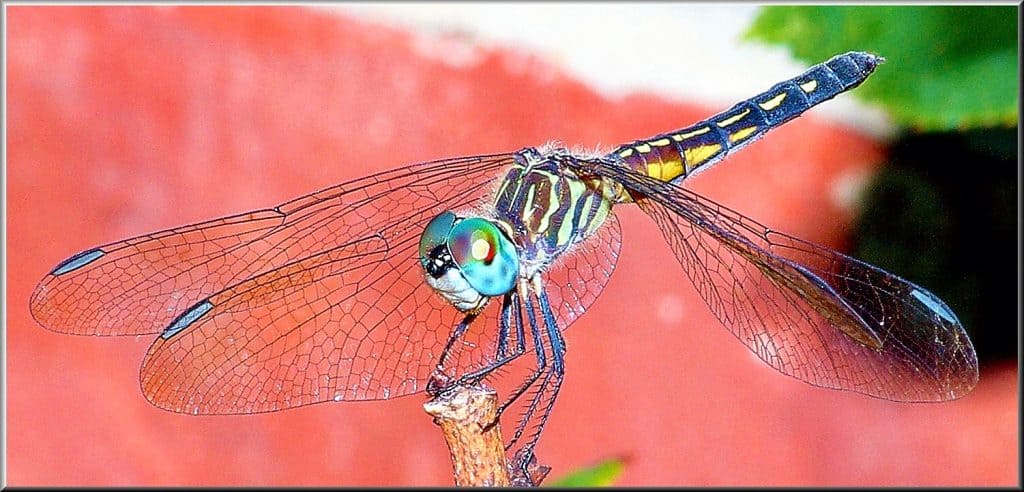Here’s what’s blooming in town this week to make your walks more enjoyable
By Laura Eisener
The beautiful blue dasher dragonfly (Pachydiplax longipennis) shown above paid a visit to Charlie Zapolski’s house in North Saugus, where he photographed it with a Pentax 100 mm macro lens. Dragonflies are among the more enjoyable insects of summer, appearing in open areas, with a diet of small insects rather than plants. Blue dashers belong to the skimmer dragonfly family (Libellulidae), so-called because most members of this family live near ponds or other bodies of water. They skim the water’s surface searching for food in and just above the water’s surface. They are sometimes known as pond dragonflies for this reason. They are also called perchers because they frequently perch on a twig or other object to search for flying prey. They eat a wide variety of small insects, but among their most frequent prey are mosquitos, which means they help make summer evenings more pleasant for people!
White dunce cap mushroom (Conocybe apala), also known as milky conecap, is a common lawn fungus. The reproductive portions of the fungus are known as the fruiting body or mushroom portion. In this species the mushroom is usually pale tan with a slender stalk, the cap somewhat conical, sometimes bell-shaped, and occasionally I will see one that looks a bit more like a cowboy hat. This fungus is not particularly harmful to the grass and feeds on organic matter in the soil. Most of the time it is not noticeable until the right weather conditions occur for the fruiting bodies to develop, generally when soil is wet from frequent rains and air is warm and humid. This mushroom has appeared in recent weeks in many locations, such as the mowed lawns at Saugus Ironworks, and in my own lawn and many other lawns I have walked by. It is not very large so would probably not be noticeable to most people driving past. These mushrooms usually only last a few days.
Scaevola or fan flower (Scaevola aemula) is a native of Australia and the Pacific Islands that may have pink, light purple or white flowers. Its common name comes from the asymmetrical arrangement of the five petals, which look like a fan. It also looks to many people like half of the more familiar radial arrangement of petals, as in a daisy, which has given rise to stories about parted lovers trying to find the flower’s other half.
While cool season leafy greens like lettuce don’t thrive in the warm weather we’ve been having the last few weeks, such greens as spinach (Spinacia oleracea) and Swiss chard (Beta vulgaris cicla) continue to grow and can be harvested continuously through the summer. Swiss chard is a variety of the same species as the beet (Beta vulgaris vulgaris) we grow for its roots as well as sometimes for beet greens, so they are similar to beet greens in flavor. The main difference is that chard varieties have been developed for superior leaf flavor, while beet root varieties have been bred for the size and flavor of the roots. While beets, spinach and quinoa (Chenopodium quinoa) are sometimes classified in the goosefoot family (Chenopodiaceae), many scientists now consider this a subfamily of the amaranth family (Amaranthaceae). It is both a tasty vegetable and an ornamental plant, as many popular varieties have colorful leaf stalks – red, bright pink, yellow, orange, white as well as green – and leaf colors may be green or dark red/burgundy. The taste is similar to spinach but with a slight lemony flavor, in my opinion, and I usually sauté the leaves alone or along with meat or other vegetables.
Now that the warm weather and some sunshine have arrived, many warm season vegetables are reaching harvest time. Most green beans have passed their peak of production, but it is possible to plant more bush beans at this time for an early fall crop. The Swiss chard can continue to be harvested a few leaves at a time until fall. Peppers are producing now in the community garden, as well as eggplants, and the long-awaited tomatoes are beginning to ripen. Bees have been sighted enjoying the flowers this summer, but other pollinators have been somewhat scarce this year. Several kinds of butterflies are finally showing up, and a hummingbird has been visiting several flowers in my garden the last few weeks.
Editor’s Note: Laura Eisener is a landscape design consultant who helps homeowners with landscape design, plant selection and placement of trees and shrubs, as well as perennials. She is a member of the Saugus Garden Club and offered to write a series of articles about “what’s blooming in town” shortly after the outbreak of the COVID-19 pandemic. She was inspired after seeing so many people taking up walking.
See photo highlights at: www.Facebook.com/Advocate.news.ma



